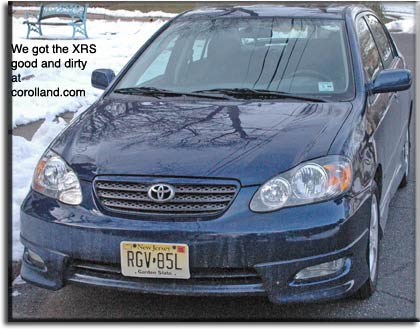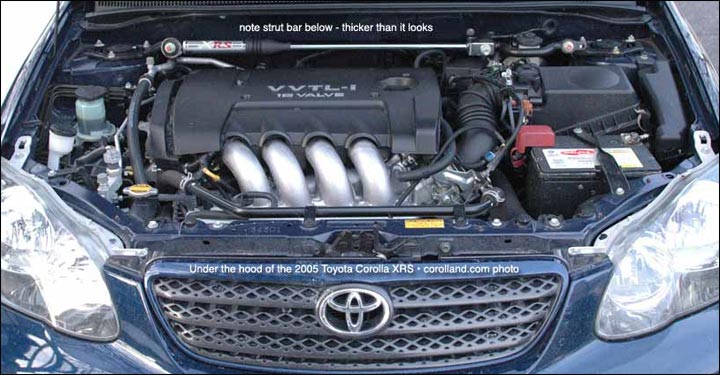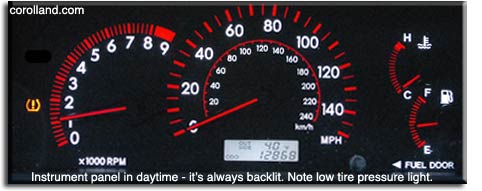The Toyota Corolla XRS - now with road test (car reviews)

 The Toyota Corolla XRS sport sedan was first shown in November 2003.
Featuring a newly tuned version of Toyota's 2ZZ dual overhead cam
engine and six-speed manual transmission (found in the Celica GT-S and
Corolla Matrix XRS), the car should be able to outrace the Ford Focus
SVT and Honda Civic Si. The increase in power will be complemented by
improved ride and handling, thanks to a sport-tuned suspension and new
steering improvements.
The Toyota Corolla XRS sport sedan was first shown in November 2003.
Featuring a newly tuned version of Toyota's 2ZZ dual overhead cam
engine and six-speed manual transmission (found in the Celica GT-S and
Corolla Matrix XRS), the car should be able to outrace the Ford Focus
SVT and Honda Civic Si. The increase in power will be complemented by
improved ride and handling, thanks to a sport-tuned suspension and new
steering improvements.
The 1.8 liter engine produces 170 horsepower but only 127 lb-ft of
torque - roughly the same torque as the standard Corolla, and ten
horsepower less than the same engine in the Celica and Matrix XRS. The
engine
has been retuned to deliver a broader and stronger mid-range power
curve, but continues the variable valve timing and lift system for a
turbo-like rise in power starting at 7,000 rpm
and going up to redline at 8,200 rpm. The result, along with the
Corolla's relatively light weight, is a zero-to-sixty time under eight
seconds coupled with good throttle response - and gas mileage of 25
city, 32 highway. We found it much more enjoyable than the Matrix XRS,
where the lack of low-end torque hurts everyday responsiveness.
The XRS features a sport-tuned suspension that includes a front connecting rod damper developed by Yamaha. The damper is mounted between the shock towers to produce improved ride and handling without compromising NVH. In addition to the performance damper, the XRS features increased rate coil springs and shocks on all four wheels for improved roll and pitch, and a ride height that is lower by a full half-inch. The suspension stands on 16-inch aluminum alloy wheels and Michelin performance tires (all other Corollas use 15 inch wheels). It is complemented by a steering system that features a more rigid steering column, producing less vibration and improved response, and a special power steering rack for better feedback.
There are also cosmetic changes including sport seats, color-keyed bezel surrounding the grille, silver-colored center cluster and switch plates, a leather-like shift boot with a leather shift knob, and unique badging.
The Corolla XRS is built at Toyota Motor Manufacturing, Canada
(TMMC) in Cambridge, Ontario alongside the Matrix, and started
production in April 2004. Annual sales of the XRS are projected at
approximately 5,000 units, so it's mainly a publicity piece - something
to make the ordinary Corollas seem more sporty, just as
aftermarket-modified Civics make the rather dull production Civic seem
sportier.
Toyota Corolla XRS road test ( car reviews )
 The
Toyota Corolla XRS is more Celica than Corolla in many ways,
with an engine that's happiest above 7,000 rpm, a firm ride bordering
on harsh, and a flat black interior; it performs like no other
Corolla, and its speed and agility live up to the spoiler on the back.
The
Toyota Corolla XRS is more Celica than Corolla in many ways,
with an engine that's happiest above 7,000 rpm, a firm ride bordering
on harsh, and a flat black interior; it performs like no other
Corolla, and its speed and agility live up to the spoiler on the back.
The first thing that stands out on any new Corolla is the new Camry-style nose, though the
tail end is similar to the older models. While it is well thought out, the interior doesn't look
nearly as classy as those past 'Rollas, except for the newly jazzed up
instrument panel, which is brightly backlit whether the headlights are
on or not, a styling cue that a few years ago was the domain of luxury
and semi-luxury brands. The red and white display - red for the needles
and hash marks, white for the numbers, legends, and LCD odometer
backlighting - is brilliant during the day and at night, and shows
clearly in all types of light. It's also easily adjusted from a
convenient dial that's always visible. Speaking of visibility, aside
from a large rear pillar, the Corolla has excellent visibility in all
directions, even at night, thanks to bright, well-focused headlights.
The main feature of the XRS is the 170 horsepower Celica engine, a
performance-tuned version of the standard Corolla fare, so it's worth
looking at that first. At lower revs, it actually seems less feisty
than the base Corolla powerplant, which produces about 40 fewer horses
but roughly equal torque. At higher revs, though, it's definitely
quicker, and at about 7,000 rpm, when the valve timing program
suddenly changes, there's a power boost similar to an older
turbocharger spooling up. Just having an engine that can rev to 8,000
rpm or so is an advantage, since it means you can stay in gear and in
the power band longer; shifts take time and can drop you down below
peak torque. However, this sort of tuning means that while 0-60 times
are good, unless you happen to be in the right gear, you won't be
getting much benefit; toll booth and stoplight acceleration are
excellent, but ordinary around-town driving isn't any better than a
standard Corolla. Don't get us wrong - the XRS is just fine around
town, but you won't mistake it for a Corvette or a Tacoma V6. Still,
that same behavior makes the Corolla XRS easy to drive gently for the
sake of less enthusiastic passengers, and prevents it from being a
"needs your attention" sort of beast. Except for that spurt near
redline, power builds up gradually, without the kind of surprises a big
turbocharger can bring. There's also no need to get to that last spurt;
there's plenty of power and speed anywhere from 4,000 rpm on up. But
those who live for the thrill may waste a lot of fuel and engine life
keeping the revs up and the gears down so they can reach the high-lift
cam program.
We should note here that most sources, including Toyota's press
release, claim the boost comes at 6,000 rpm and that the redline is
7,600 rpm. We suspect they took that from a past version of the 2ZZ or
simply got it wrong; our experience and Car & Driver's reporting
both say the boost comes at 7,000 rpm, with a redline of 8,200 (which
is how the tachometer is marked). Likewise, while all Toyota claims is
"under 8 seconds," Car & Driver got 7.1, and we suspect ordinary
people will find 7.5-7.8 to be the ordinary range - a little faster
than the Honda Civic Si and Neon R/T, but nowhere near the Subaru SVX
or Dodge SRT-4.

The XRS also has different gearing, which is fairly similar to the
now-departed Dodge Neon ACR. That means the engine is revving high on
the parkway, which is probably the main reason why the XRS is rated
well below ordinary Corollas in gas mileage at a still-respectable 26
city, 34 highway; and the faster you go, the lower the mileage drops,
as engine speed increases. But the XRS will still be responsive in
sixth gear, and, indeed, the engine generally seems happy and responsive in higher
gears (or, conversely, at lower rpms). The low gearing also makes for more engine noise on the highway,
and this engine seems noisier than the standard one. Wind is also
surprisingly loud at highway speeds.
 Getting into gear is a little tougher than on five-speed models;
reverse is in the traditional German location (off to the left), and
while a constant beeping alerts you to being in reverse, we miss the
mechanical stop that some cars have to prevent accidental movement into
reverse. The reverse gear is, to be fair, very far off to the left. It
took some getting used to the relative positions of first and third,
but perhaps that was just us. The clutch is, as we'd expect from a
Toyota, very smooth and easy to use; it took no getting used to at all.
Getting into gear is a little tougher than on five-speed models;
reverse is in the traditional German location (off to the left), and
while a constant beeping alerts you to being in reverse, we miss the
mechanical stop that some cars have to prevent accidental movement into
reverse. The reverse gear is, to be fair, very far off to the left. It
took some getting used to the relative positions of first and third,
but perhaps that was just us. The clutch is, as we'd expect from a
Toyota, very smooth and easy to use; it took no getting used to at all.
Cornering is far better than ordinary Toyotas, with very little body
roll and the large strut bar and extra-sized front and rear stabilizer
bars clearly doing their work. Whipping around corners didn't feel as
confident as it could, but the Corolla XRS still gripped the road
extremely well, dealing with bumps and dirt around turns well, and not
squealing until driven at speeds most drivers would not take turns at.
In short, cornering performance is excellent, and makes the Corolla a
far better choice for enthusiastic drivers.
Inside, the normal ergonomic seats and controls were present, albeit a
bit stripped-down. The plush fabric of the previous-generation Corollas
is gone in the XRS, replaced by a coarse, tough-looking black fabric
that grips better and is probably better for high-speed turns. The
center console feel is not quite as high-quality as in prior models,
and the sunroof cover rattled when in any position other than
completely closed, but otherwise the interior seemed well constructed.
Our XRS had black on nearly every surface, with some dull silver
panels (one around the door switches on each door, and others at the
bottom of the center stack) and a chrome inset on the six-speed
gearshift. Most controls are logical and clearly marked, with the
climate control having especially large buttons and knobs for easy use
with gloves on. Twin cupholders up front are fairly primitive but deep
enough to work well. The glove compartment has room for more than just
the owner's manual, and both front doors have map pockets; there is
also a small bin on the left of the wheel, and two compartments under
the climate control (these may not be on every model), which could have
had rubberized bottoms to prevent rattling, but don't. The optional
six-disc in-dash CD with six speakers ($200) has good sound and stereo
separation, and is also easy to use, though it has the single-button
audio control that is less than ideal for use while driving (press to
get to bass, treble, etc., then turn to go up or down five
stops). A large LED clock sits in the middle of the center
console, and the outside temparature is shown with the odometer. There
is a large tachometer, especially useful in this particular car with
its "high rpm" program, and gas and temparature gauges.

The trunk is surprisingly large; rear seats are comfortable and about
as spacious as you'd expect in this class, which is to say spacious
enough to accommodate adults or children in booster seats, without
inconveniencing the people up front, as long as there aren't tall
people in both front and back.
Our test car had the optional sunroof ($1,400 with side curtain
airbag); its overhead controls are easy to figure out, one for slide
and one for tilt, with no auto open or close. Our test car also had the
all-weather guard package ($70 and worth it), power windows and
wireless door locks ($605), and the inevitable floor mats ($87). These
all took the reasonable list price of $17,970 up to $20,332 (both
including destination), which, incidentally, is Dodge Neon SRT-4
territory - except that the SRT-4 has blistering performance without
the need to climb all the way up the tachometer. A more favorable
comparison would be against the Focus SVT, which has nowhere near the
reliability (if surveys are any indication) and looks and feels cheap
inside, without offering more performance. We'd also rate the Corolla
XRS favorably against the current Honda Civic Si; the Corolla is more
comfortable, generally sits higher on reliability charts (the Civic
seems to have been slipping), and the feel and performance are both better.
We do have to admit that it took some time for us to
become comfortable with the Corolla XRS and to gain respect for it, at
least partly because it is
such a departure from past 'rollas. It wasn't until we took it out of
town and onto the highway, and had the opportunity to take some
high-speed corners and get first gear up to over 7,000 rpm, that we
really discovered the advantages of this new breed and gained respect
for it, more respect than we have for its sibling, the Matrix XRS, or the running-on-fumes, odd-looking Honda Civic Si.
Think of the Corolla XRS not as a Corolla, but as a four-door Celica
with better visibility, a large trunk, usable rear seats, and a lower
price. We think the Corolla XRS is a nice package for those who do more
highway than city driving, and would like something that feels and acts
sporty, yet sips fuel, is docile enough to carry the family around in,
and will last a long, long time.
You can sponsor this site and Toyoland to remove all but your own ads.
This Toyota Corolla-focused site is copyrighted © 2000-2023 Zatz LLC.

